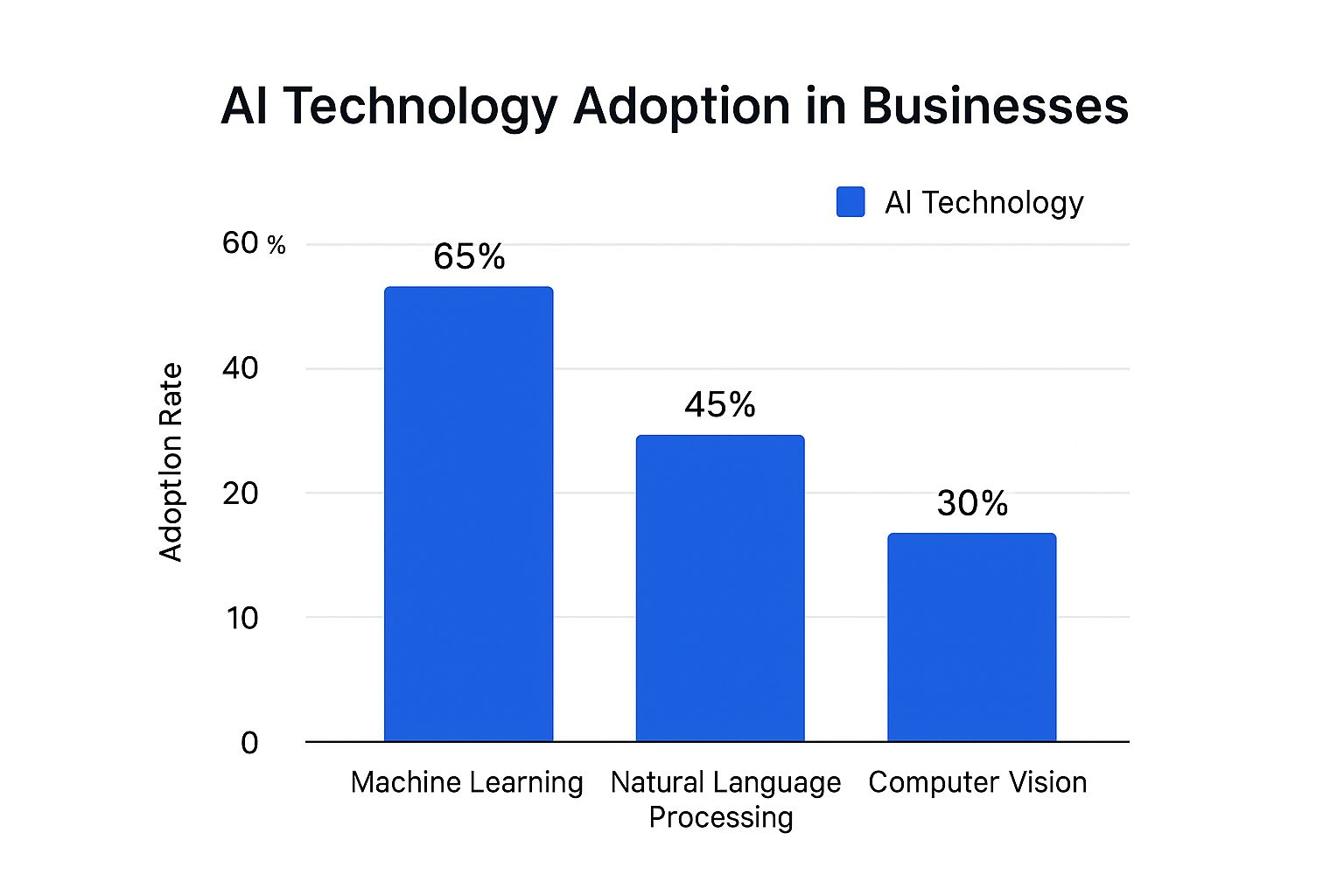How to Implement AI in Business a Practical Guide

To get started with AI, forget the technology for a moment. Instead, pinpoint a specific, high-impact problem you're facing. Are you drowning in customer support tickets? Are your sales forecasts consistently off the mark? As our expert speakers often advise, successful integration is about solving real business challenges, not just plugging in new tech because it's popular. This focused approach is the secret to getting a clear return on investment right from your very first project.
Why AI Implementation Is No Longer Optional
The entire conversation around artificial intelligence has shifted. It’s no longer a futuristic keynote topic; it's a present-day competitive necessity. Putting off AI adoption isn't just a passive choice anymore—it's an active decision to fall behind. The gap between businesses that use AI and those that don't is widening fast, turning AI from a nice-to-have into a core driver of modern efficiency and growth.

This guide is built on a theme our expert speakers constantly stress: winning with AI isn’t about chasing trends. It's about strategically applying technology to solve tangible business problems. Whether that means automating repetitive tasks to free up your team's time or analyzing data to uncover new market opportunities, the goal is always to achieve measurable results. Our roster of entrepreneurship keynote speakers leading the AI charge offers incredible insights into how to approach this journey.
The Urgency of Now
The rapid adoption rate among leading companies really highlights the urgency. By mid-2025, a staggering 67% of Inc 5000 companies are expected to be using artificial intelligence in their operations. This shows a massive shift from early adoption by huge corporations to rapid, mainstream use across every sector.
These companies are reporting efficiency gains as high as 40% and, in some wild cases, revenue jumps of up to 3,000%. This data paints a very clear competitive picture. Businesses aren't just experimenting anymore; they're achieving substantial results, making it much harder for others to ever catch up.
The biggest mistake companies make is viewing AI as a technology project. It's a business transformation project. The technology is just the enabler, but the strategy must be rooted in solving a customer or operational pain point.
From Hype to Practical Application
Knowing how to implement AI in your business means cutting through the noise. You have to focus on practical applications that actually deliver value. This requires a clear-eyed look at where your organization can benefit the most.
Some of the most common starting points include:
- Customer Experience: Using AI to provide 24/7 support through chatbots or personalizing marketing messages at scale.
- Operational Efficiency: Automating routine admin tasks, optimizing supply chains, or using predictive maintenance to slash downtime.
- Data-Driven Decisions: Analyzing massive datasets to spot market trends, forecast demand, and make smarter strategic choices.
Resources like the AI for Customer Experience: Your Complete Success Playbook really drive home how big of an impact AI can have on customer interactions. This guide will give you the actionable framework you need, setting you up to build your own strategic roadmap and get started now.
Building Your Strategic AI Roadmap
Diving into artificial intelligence without a plan is like setting off on a cross-country trip with no map. Sure, you might end up somewhere interesting, but it almost certainly won’t be where you intended to go. A successful journey starts with a strategic framework—a clear roadmap that guides your first steps and ensures every action moves you toward a specific business goal.
This isn’t about chasing the latest AI trend. As our roster of expert speakers consistently advises, the critical first move is to pinpoint a high-impact business challenge that AI is uniquely positioned to solve. Start with the problem, not the technology.
To get AI right, you first need to understand how to build a practical AI strategy for your business that lines up with your broader objectives. This foundational work stops you from sinking money into flashy projects that ultimately deliver little real value.
Conduct an Honest Readiness Assessment
Before you can move forward, you need a brutally honest picture of where you stand right now. This means taking an internal look at your organization's readiness across a few key areas. It's not about being perfect; it's about being prepared.
Your assessment should be an unflinching look at three core components:
- Data: Is your data accessible, clean, and actually relevant to the problem you want to solve? You don't need a flawless, enterprise-wide data warehouse, but you absolutely need a quality dataset for your first project.
- Infrastructure: Do you have the necessary cloud computing resources or on-premise hardware to support AI tools? Many modern AI platforms are cloud-based, which can dramatically lower the initial infrastructure burden.
- Skills: What capabilities does your team have today? Find the tech-savvy people who can champion the project and identify any skill gaps that might require training or bringing in outside help.
This evaluation helps you gauge your AI maturity and shines a light on potential roadblocks before they become serious derailments. It’s a vital reality check that grounds your strategy in the real world.
Form a Cross-Functional Steering Committee
Rolling out AI isn't just an IT project; it's a business initiative that touches multiple departments. One of the best ways to get everyone on board and aligned is to form a cross-functional AI steering committee.
This group should include stakeholders from key business units like marketing, sales, operations, and finance, sitting alongside your IT or data science teams. Their collective mission is to guide the AI strategy, prioritize use cases, and knock down internal barriers to progress. This collaborative approach ensures that AI initiatives are directly tied to real operational needs and have broad support right from the start.
A key lesson from years of management research is that culture eats strategy for breakfast. If you don’t understand the cultural and organizational aspects of change, then your best strategies will simply not work.
This classic insight, often shared by business transformation experts on our roster, underscores why getting a diverse group of people involved is so critical for success.
Define Sharp and Measurable KPIs
How will you know if your AI initiative is actually working? The answer lies in defining sharp, measurable Key Performance Indicators (KPIs) before you even think about launching. Vague goals like "improve efficiency" just won't cut it.
Your KPIs have to be specific and directly linked to the business problem you’re solving. Think in concrete terms that your leadership team can understand and get behind.
Consider these examples of strong, problem-focused KPIs:
- For a customer service chatbot: Reduce average customer response time by 30% within the first quarter.
- For a sales forecasting model: Increase forecast accuracy by 15% over the next six months, leading to a 5% reduction in excess inventory.
- For marketing content generation: Decrease the time to create first-draft blog posts by 50%, allowing the team to double its content output.
These kinds of metrics transform your AI project from a technological experiment into a measurable business investment. They give you the hard evidence you need to prove value, secure future funding, and build momentum to scale your efforts across the entire organization.
Pinpointing the Right AI Use Cases
With your strategic roadmap in hand, it’s time to get your hands dirty. We're moving from the 30,000-foot view down to the factory floor, where the real AI opportunities are waiting to be discovered. The goal here is to find specific, tangible problems that AI can solve right now, not just chase futuristic buzzwords.
Thinking about how to implement AI in business really starts with looking at your daily grind. Where are the bottlenecks? What repetitive tasks are eating up your team's valuable time? Are you leaving money on the table because you can't sift through customer data fast enough? These pain points are goldmines.
Identifying High-Impact Opportunities
The trick is to zero in on use cases that deliver clear, measurable results. It's easy to get sidetracked by shiny, complex projects that take years to pay off. Instead, look for "quick wins" that build momentum and prove AI's value to the entire company.
Start by auditing your core business functions:
- Marketing: Imagine using generative AI to create dozens of personalized email variations in minutes, not days, and watching engagement rates soar.
- Sales: What if you could use predictive analytics to score every new lead, telling your sales team exactly who to call first for the highest chance of closing a deal?
- Operations: Think about implementing AI-powered tools to fine-tune your inventory, cutting down on waste while making sure you never run out of your best-sellers.
- Customer Service: You could deploy AI chatbots to handle the most common customer questions 24/7, freeing up your support agents to solve the truly tough problems.
Adoption of these technologies is already well underway. In fact, foundational tech like Machine Learning is practically mainstream.

This data shows that businesses aren't just experimenting anymore; they're building core processes on top of AI.
Prioritizing Your AI Initiatives
Let's be clear: not all AI projects are created equal. Some promise a massive payoff but come with an equally massive price tag in time and resources. Others are easier to get off the ground but only deliver modest improvements. The secret is finding the sweet spot for your business.
To do this, you need to weigh the potential business impact against the technical and organizational complexity. This isn’t just a gut feeling; it’s a strategic decision.
"Don't boil the ocean. Start with a teacup. Find a small, well-defined problem that’s causing real pain and apply AI to solve it. A quick, visible win is the best way to build the confidence and political capital you need for bigger projects down the road."
This is a piece of advice we hear constantly from our top AI speakers. It's about steering clear of the giant, high-risk "moonshot" projects and instead focusing on smart, iterative progress. You want to create a positive feedback loop where every successful pilot project unlocks more support and resources for the next one. Many leading sales and marketing AI speakers build their entire philosophy around this focused, results-first approach.
And the clock is ticking. As of 2024, 78% of organizations worldwide are already using AI in at least one business function. Adoption in IT departments alone jumped from 27% to 36% in just six months. Even more telling, generative AI is now regularly used by 71% of businesses surveyed, a staggering leap from 33% in 2023. You can dig deeper into these numbers in the full AI Index report from Stanford HAI.
A Practical Comparison Framework
To make your prioritization process less about guesswork and more about strategy, a simple comparison table is your best friend. It provides a structured way for your team to discuss where to place your bets.
Prioritizing AI Use Cases Impact vs Complexity
This table helps businesses evaluate potential AI projects by comparing their potential business impact against the technical and organizational complexity of implementation.
| Business Function | AI Use Case Example | Potential Impact (Low/Med/High) | Implementation Complexity (Low/Med/High) |
|---|---|---|---|
| Marketing | AI-driven content personalization | High | Medium |
| Sales | Predictive lead scoring | High | Medium |
| Customer Service | 24/7 AI-powered chatbot | Medium | Low |
| Operations | Supply chain optimization | High | High |
| Finance | Automated invoice processing | Medium | Low |
Looking at a framework like this, the "low-hanging fruit" immediately jumps out. An AI chatbot for customer service or an automated invoice processor in finance offer solid returns for a relatively low lift. These are perfect candidates for a first pilot project, letting you demonstrate value and learn quickly without betting the farm.
Launching Your First AI Pilot Project
Theory and strategy are great, but the real learning starts the moment you launch your first AI pilot project. This is where you trade planning for doing, turning those abstract ideas into a tangible solution that shows real-world value. The key is to start small, move fast, and focus on a minimum viable product (MVP) that solves one specific, measurable problem.

This first project isn’t about perfection; it's about proof. It's your chance to test assumptions, learn from actual data, and give stakeholders a glimpse of what's possible. An agile, iterative approach is your best friend here. It lets your team adapt on the fly, making small adjustments along the way instead of getting locked into a massive, rigid plan that could easily go off the rails.
Assembling Your Lean Project Team
You don't need a huge department to get a pilot off the ground. In fact, a small, dedicated, cross-functional team is way more effective. This nimble group can make decisions quickly and stay laser-focused on the goal without getting stuck in corporate quicksand.
Your ideal pilot team should have:
- A Project Champion: A leader from the business side who feels the pain of the problem you're solving and can rally support for the project.
- A Technical Lead: Someone with the technical chops to guide the selection and implementation of the AI tool or platform.
- Subject Matter Experts: The people who live and breathe the process you're improving every day. If you’re automating sales reports, you absolutely need a salesperson on the team.
- A Project Manager: The person who keeps the trains running on time, clears roadblocks, and makes sure everyone is on the same page.
This structure grounds your project in both business reality and technical feasibility right from the start.
The Critical Build vs. Buy Decision
One of the first big forks in the road your team will hit is whether to build a custom AI solution or buy an existing one. For most companies dipping their toes into AI for the first time, "buy" is almost always the smarter path. Building custom AI from scratch is a massive undertaking, demanding specialized talent and a huge investment of time and money.
Opting for an off-the-shelf platform lets you get started much faster with far less risk. Providers like Salesforce or HubSpot now have powerful AI features baked right in. This approach lets you tap into advanced tech without needing an in-house team of data scientists. The goal of a pilot is to prove value, and buying a solution is the quickest way to get there.
Many companies fall into the trap of thinking they need a completely unique, custom-built AI model. In reality, 90% of business problems can be solved more effectively and affordably with existing tools. Focus on the problem, not on building a complex new technology.
This common-sense advice, often echoed by our roster of seasoned AI speakers, highlights a critical pitfall. The temptation to build something novel can distract from the main goal: solving a business problem efficiently.
Navigating Governance and Data Security
As you kick off your pilot, data privacy and security can't be an afterthought. They have to be woven into your project plan from day one. You need to establish clear governance from the outset to avoid potential legal, ethical, and reputational nightmares down the road.
Your governance framework should cover a few key areas:
- Data Privacy: Make sure you have the proper consent to use customer or employee data and that you're following regulations like GDPR or CCPA.
- Data Security: Put robust security measures in place—like access controls and encryption—to protect the data your AI system will handle.
- Algorithmic Transparency: Even if you're not building the algorithm yourself, you need to understand how your chosen tool makes its decisions. This is crucial for troubleshooting and ensuring fairness.
Building your first project on a solid, responsible foundation doesn’t just reduce risk; it builds trust with your customers and your own teams. It shows you're not just thinking about how to implement AI in business for a quick win, but are committed to doing it ethically and sustainably for long-term success.
Measuring ROI and Scaling Your AI Strategy
Getting a pilot project across the finish line is a huge win. But it’s also just the starting line. The real work begins now: proving the tangible business value of your AI investment and turning that initial success into a company-wide movement. This is where you connect the dots from a single project to your long-term vision.
It’s time to stop talking in technical terms and start speaking the language of business outcomes. Your leadership team doesn’t just care that an algorithm has a 95% accuracy rate; they want to know how that accuracy impacts the bottom line through cost savings, new revenue, or happier customers. Making this pivot is absolutely essential for building momentum.
Translating KPIs into Business Value
You set clear, measurable KPIs in your roadmap, and now it’s time to report on them—relentlessly. Frame every single data point as a concrete win for the business. Don’t just throw a dashboard at them; tell a compelling story backed by hard numbers.
This means you need to get specific and move beyond fuzzy benefits:
- Cost Savings: Show exactly how much you saved by automating a manual process. Did you reduce employee hours by a specific amount? Did you cut down on operational waste? Quantify it.
- Revenue Growth: Can you connect your AI-powered sales forecasting to a measurable lift in closed deals? Did you reduce stockouts of your most popular products? Show the direct link.
- Customer Retention: If your new AI chatbot improved customer response times, tie that metric directly to a rise in CSAT scores or a drop in your churn rate.
When you do this, you’re not just reporting on a project. You’re building an undeniable business case for the next round of investment. The numbers do the talking, turning skepticism into enthusiastic support.
The goal isn't just to complete a pilot. The goal is to use the pilot as a lever to create systemic change. A well-executed and well-communicated success story becomes the catalyst for the next, bigger initiative.
This is a perspective we hear all the time from experienced AI speakers on our roster. They see that first project as a strategic tool designed to create a ripple effect that goes far beyond its initial scope.
Communicating Success and Building Momentum
Once you have your success story nailed down, you need to share it. A concise, visually engaging presentation focused on business outcomes will always be more powerful than a dense technical report. Keep it simple and focused on what matters to the C-suite.
The potential payoff for scaling this is massive. Businesses that fully embrace AI are projected to see a 38% increase in profitability by 2025. On top of that, automating repetitive tasks in departments like customer support and HR is expected to generate annual savings of over $80 billion. The numbers are just too big to ignore. For a deeper dive, you can review key AI adoption statistics from Exploding Topics.
Evolving from Projects to a Center of Excellence
As you start racking up more successful AI projects, you’ll naturally shift from running isolated initiatives to building a true, enterprise-wide AI capability. This is the endgame of knowing how to implement AI in business for keeps. Many companies make this official by establishing a dedicated Center of Excellence (CoE).
A CoE becomes the central hub for all things AI—knowledge, best practices, governance, and talent. It ensures your AI strategy stays aligned with core business goals, prevents different teams from reinventing the wheel, and fosters a culture of smart, data-driven innovation. Getting expert guidance can be a game-changer here; exploring professional AI consulting and advisory services can provide the strategic blueprint needed to build a mature and effective AI program.
Common AI Implementation Questions
As you move from strategy to action, the practical questions inevitably start bubbling up. Navigating how to implement AI in business isn't just about big ideas; it's about having clear answers to the real-world hurdles you'll face. We’ve gone straight to our expert speakers to get direct, no-fluff answers to help you push forward with confidence.

This final section is all about tackling those lingering "what ifs" and "how tos." Let's dive into the questions leaders ask most often when they get serious about making AI a reality.
How Much Does It Cost To Implement AI in a Small Business?
The cost of AI can range from a monthly Netflix subscription to a Super Bowl ad, which can feel both liberating and paralyzing. The key thing to remember is that you absolutely do not need a massive budget to get started. Your entry point depends entirely on your approach.
For most small and medium-sized businesses, the smartest, most cost-effective path is to begin with existing AI-powered software.
- SaaS Subscriptions: This is the easiest on-ramp. Subscribing to a CRM or marketing automation tool with built-in AI can start at just a few hundred dollars per month.
- Custom Builds: On the other end of the spectrum, building a custom machine learning model from the ground up can easily run into the tens, if not hundreds, of thousands of dollars.
The smart money is on starting with off-the-shelf tools that solve a specific, high-pain problem. This lets you see a clear return on your investment without a huge upfront capital risk. Look for solutions with transparent pricing and proven case studies in your industry.
Do I Need to Hire a Data Scientist to Use AI?
Not necessarily, especially when you're just getting started. One of the biggest (and best) shifts in the AI space is the rise of "no-code" or "low-code" platforms. These tools have made AI accessible to business analysts, marketers, and other tech-savvy team members—not just people with PhDs.
You can now integrate powerful AI for tasks like sales forecasting, content generation, or customer sentiment analysis without writing a single line of code. The need for a dedicated data scientist really only kicks in when you start venturing into highly complex, custom projects that require building unique algorithms from scratch.
The most common mistake we see is companies focusing on the technology instead of the business problem. They get excited about 'doing AI' without a clear goal, leading to expensive projects that deliver zero value.
This insight, shared time and again by our speakers, is gold. A successful AI project always starts with a business question like, "How can we reduce customer churn by 10%?" not "How can we use a large language model?" Always, always tie your AI initiative to a specific, measurable business outcome.
What Is the Biggest Mistake Companies Make When Implementing AI?
Hands down, the number one pitfall is putting the technology cart before the business-problem horse. Too many organizations get swept up in the hype and decide they need an "AI strategy" without first defining what problem they're actually trying to solve.
This leads to what's often called "AI for AI's sake"—expensive science projects that go nowhere. A successful AI project is a business project first and a technology project second. It must be anchored to a clear, quantifiable goal.
How Do I Get My Company's Data Ready for AI?
Data readiness is non-negotiable, but—and this is a big but—it doesn't mean you need perfectly clean data across your entire organization before you can begin. That's a recipe for analysis paralysis.
Instead, focus on getting a high-quality, relevant dataset ready for your first project.
Here’s a practical way to approach it:
- Start with a Data Audit: First, just figure out what data you have, where it lives, and who owns it. You can't use what you can't find.
- Focus on Data Quality: For your chosen pilot project, dig into the data. Check for accuracy and completeness. Remember the golden rule: garbage in, garbage out. Bad data will always lead to flawed AI insights.
- Ensure Accessibility: Make sure the data is actually accessible to the tools and teams that need it. This might mean finally breaking down a data silo between departments.
- Establish Governance: From day one, create clear policies for data privacy and security. This isn't just about compliance; it's about building trust with your customers and your team.
By narrowing your focus to the data needed for one specific use case, you make the task manageable and start building good data habits for all your future AI projects.
Ready to bring this level of expertise to your next event? The speakers at Speak About AI provide the actionable insights your team needs to navigate the complexities of AI implementation and drive real business results. Explore our roster of world-class AI experts and book your speaker today.
